#rosemary anne sisson
Explore tagged Tumblr posts
Text




youtube
Candleshoe (1977)
My rating: 5/10
So I guess somebody saw Anastasia (the Yul Brynner one, obviously, the cartoon was not even a twinkle in Don Bluth's eye when this was made) and decided the plot needed significantly more shenanigans and hijinks and also pirate treasure. It's fine I guess?
#Candleshoe#David Swift#Rosemary Anne Sisson#Michael Innes#Jodie Foster#David Niven#Helen Hayes#Youtube
4 notes
·
View notes
Text



Top, L-R: Rosalie Crutchley as Catherine Parr in The Six Wives of Henry VIII (1970), Episode 6: Catherine Parr (written by John Prebble)
Bottom: Rosalie Crutchley as Catherine Parr in Elizabeth R (1971), Episode 1: The Lion's Cub (written by Rosemary Anne Sisson)
edited by me
#tudor era#the six wives of henry viii 1970#elizabeth r#catherine parr#katherine parr#rosalie crutchley#perioddramaedit#tudorerasource#dailytudors#was this a good Parr depiction?#ehhhhhh#it gets across her piety and learning#but very little else#there's very little sense of spirit#crutchley is the personification of sobriety in TSWOH8 1970#i mean she marries thomas seymour at the end not bc she's in love w him#but to protect henry's kids from unscrupulous counselors i -#her Protestant zeal is rly only accentuated by her sober and steady behavior#like i found it entertaining after a bit#just bc of how overly serious and religious they made her#but i'm not sure it does the real KP much justice
95 notes
·
View notes
Text
Well known in the galaxy far, far away for his work on Attack of the Clones, the Lucasfilm adventures of Jonathan Hales started a number of years before when he was invited to become a writer on what was then known as The Young Indiana Jones Chronicles. Speaking with Lucasfilm, Hales looks back to a time when the big screen adventures of Henry Jones Jr. were (for the 20th century at least) concluded, but the small screen action was only just beginning. In your initial discussions about the series, how was it explained to you? Quite simply, I was living in London and my agent telephoned me explaining that George Lucas was coming to town with an idea for a new television series. Of course, I was interested in meeting him. I went to the Pall Mall area of London, and met with George and [producer] Rick McCallum. George explained that he wanted to do a television series about young Indiana Jones, which would cover a large part of the 20th century, because that was Indy’s lifetime. He wanted it to have an education aspect. That was important to him. I liked the sound of that very much. It wasn’t much more than that. We met for about 20 minutes. I was their first meeting that day, and they had a list of other writers they were meeting with, and I remember trying to read the list upside down across the table to read the names of the other people! After about five or six days, my agent phoned up and said, “They want you to do it.” Did you start work on the series before you came to California? No. I can’t remember how long it was, maybe five or six weeks, before we all went out to San Francisco and Skywalker Ranch. Five British writers went out. [Lucasfilm research librarian] Debbie Fine had sent us all a big folder with information about Northern California, which was very nice, but that was it. Could you tell us more about this group of writers? How did these men and women work together, and did you know any of them previously? I didn’t know any of them previously. We were a disparate group coming from Britain. Matthew Jacobs was a director/writer who had done some interesting work for the BBC. Rosemary Anne Sisson had started off writing plays. She was very bright and lively, and had written a number of television shows, including a very popular one over here called Upstairs, Downstairs, which was similar to what Downton Abbey is today. Reg Gadney was a novelist who’d also written a series about John F. Kennedy for British television. Gavin Scott had been a local television reporter. When we arrived in San Francisco, we were met at the airport by Jonathan Hensleigh, who was the one American in the initial group of writers. There were six of us to begin with, and then soon after, Frank Darabont arrived from Hollywood. Later, another American named Jule Selbo joined us. We all had different ranges of experience. Read on for the full and fascinating interview. [amazon box="B0BXN5TSG2"]
0 notes
Text
The Queen and the Welshman
I read Rosemary Anne Sisson’s novelisation of this earlier in the year & planned to investigate the theatre & TV versions as best as I could and see what I could put together for history fandom here on tumblr (because it seems to still be the only filmed version of the story of Catherine de Valois and Owen Tudor). Then I kept discovering slightly different versions (it was restaged! it went on tour! there was also a radio play version!), so it got a little more complicated, but anyhooo, here are my findings about the original theatre play that started it all!
It was Sisson’s first play and her big break, and something she seems to have returned to several times over the years, hence all the different versions, but the original was performed by the London Club Theatre Group in August 1957 for the Edinburgh Fringe Festival.

It was an odd success story, as the piece was distinctly old-fashioned for the era (”history in watercolour” as one of the critics put it), but it was a hit with Festival audiences - it fared better than most of the main Festival pieces that year - and as a result launched Rosemary Anne Sisson’s career. She was a Cambridge graduate, who had previously lectured for a US University, and had written the play after being inspired by Shakespeare’s history plays to find out what happened next to Catherine de Valois. She would go on to write for many period dramas, familiar to fandom here, including The Six Wives of Henry VIII, Elizabeth R, and The Shadow of the Tower.
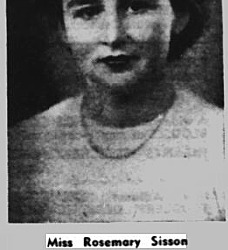
It also provided a break for its leading man - Owen Tudor was played by Edward Woodward, later to find fame as Callan and The Equalizer. (The cast seems to have been pretty good, and included a young Frank Finlay as the gaoler.)
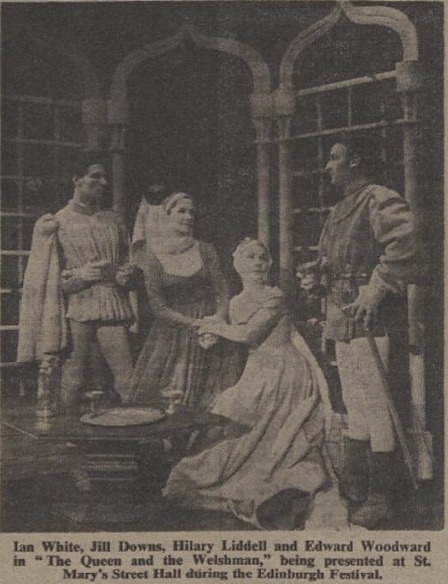
It’s hard to find many details about the story of the play, but as it includes the same original characters as her later novelised version, it’s probably safe to assume that it follows a similar path - and reviews would seem to back up that impression. (The book starts in Henry V’s wars, where Owen meets fellow soldier Villiers, later to be an embittered enemy of his, and takes a French hostage, Rainault - a rather d’Artagnan-esque Gascon noble - who remains with him, due to his uncle finding it more convenient to let his ransom go unpaid, and who eventually inadvertently betrays Owen and Katherine, plus Katherine’s maid in waiting, Margaret (who has an affair with Rainault). John of Bedford and Humphrey of Gloucester are also two major roles, as the authorities who will come down hard on the pair if they uncover their romance (Bedford reluctantly, Gloucester happily).
Critics found the play well-written, with a sensitivity to the period, “quiet sympathy and no attempt to force.” They were also taken with the historical romance it was centred around, which most of its audience had been unaware of previously. It was low-key, or perhaps a tad too “underdramatic” and one critic noted one weak scene, but it was “fastidiously” produced, well-played, with no cod-historical nonsense, and drew in and pleased its audiences; attracting attention to a promising new female playwright (the only woman to have written a play for that year’s Festival) and an actor to watch in its Owen Tudor.

[From Age for Stock; image of Hilary Liddell as Katherine de Valois.]
Hilary Liddell, who played Queen Katherine, continued to work until at least 1979, and was married to actor Bernard Hepton. She and Edward Woodward (as part of the London Club Theatre Group responsible for the production) had also acted opposite each other previously in another of the Group’s productions, The Telescope.
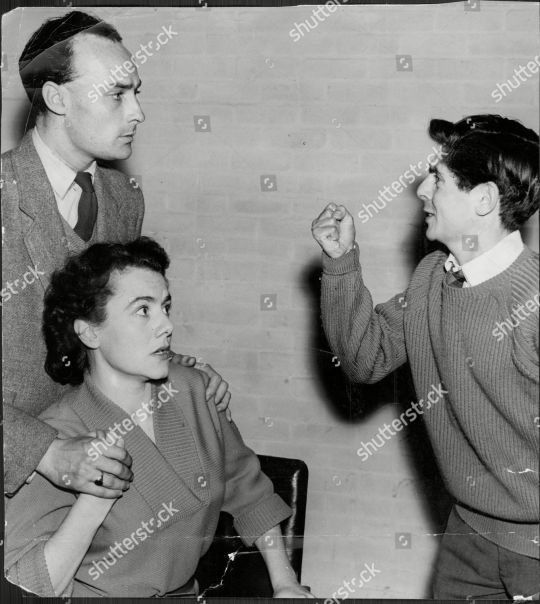
[Image from Shutterstock, of Edward Woodward and Hilary Liddell in The Telescope.]
Critics concluded it was a “gracious and beautifully acted play” and praised Edward Woodward especially. The Evening News saw Owen’s farewell to Katherine towards the end of the play as the highlight of the evening:
"Very occasionally in the theatre an actor achieves by a single gesture an effect that wings straight to the heart of an audience. Mr Woodward did so last night when, as he held the Queen in his arms for the last time, he gave her a long, slow, silent smile in which affection and brave confidence perfectly blended. It was a magic moment".
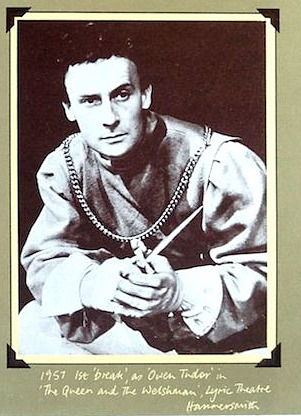
[Image taken from a scan of his music album online labelled “1957 1st ‘break’ as ‘Owen Tudor’ in ‘The Queen and The Welshman’, Lyric Theatre Hammersmith”.]
The play then transferred to the Hammersmith Lyric Theatre that autumn (with the same cast) - and after that, it went on tour, was broadcast on radio, and made into at least two TV plays, and a novel, so had a long afterlife.
Rosemary Anne Sisson evidently never forgot this first version, or its leading man. When she turned the play into a novel twenty years later, she dedicated it to Edward Woodward:
“... who long ago helped me to create Owen Tudor, and since then to prove, in twenty years of friendship, that human love and trust exist and endure, and give some meaning to life.”
sources: frankfinlay.net (Evening News & The Scotsman clippings); The Stage, The Birmingham Daily Post, Birmingham Weekly Post (BNA); IMDB (Hilary Liddell info.)
#the queen and the welshman#rosemary anne sisson#catherine de valois#owen tudor#catherine de valois x owen tudor#edward woodward#hilary liddell#frank finlay#british newspaper archive#newspapers#1950s#theatre#edinburgh festival#period drama#tudors
25 notes
·
View notes
Quote
Dead people have the same rights as we have, and I think that it's wicked- yes, wicked- to tamper with the facts. In many ways the real story is often better than some easy bit of dramatic licence. My job is to interpret the behaviour of a historical character but never to change it.
Rosemary-Anne Sisson, playwright and screenwriter
12 notes
·
View notes
Text

CANDLESHOE (Dir: Norman Tokar, 1977).
Walt Disney Poductions' Candleshoe is a comedy crime caper based upon Michael Innes' novel Christmas at Candleshoe.
Leaving the mean streets of Los Angeles, Casey Brown (Jodie Foster) heads to England to hustle the elderly Lady St Edmund (Helen Hayes) out of her dilapidated stately home Candleshoe. Within Candleshoe lays the hidden treasure of pirate Captain St Edmund to which Casey holds the first clue. In cahoots are disgraced former Candleshoe employee Clara (Vivien Pickles) and her brother Bundage (Leo Mckern) who masterminds the misdemeanour. Welcomed into the Candleshoe family, Casey turns the tables on Bundage and sets about the treasure hunt with intent to save the debt racked estate from foreclosure.
A first rate cast was assembled for this production. 15 year old Jodie Foster was fresh from her Oscar nominated turn in Taxi Driver (Martin Scorsese, 1976). She does excellent work here too and it is to her credit that she is not overshadowed by the acting heavyweights in support. Most notably David Niven, donning multiple disguises as butler, gardener, chauffeur and a visiting Colonel, in what is perhaps his best late career role.
A neat premise also lifts the movie above the usual formulaic fluff the Disney Studios were producing in the late 70s. Rosemary Anne Sisson's and David Swift's screenplay mixes humour and excitement as the race is on to recover the spoils before the bad guys. Norman Tokar directs at a surprisingly steady pace, but one that allows the mystery to unfold and for characters to develop so that Casey's change of heart is completely believable.
Candleshoe’s view of a genteel England of stately homes and steam trains must have seemed downright archaic in 1977. However, in 2019 it feels innocent and charming; nostalgic for an idealised period in British history which never really existed.
With a superior story and a distinguished cast Candleshoe is easily a highlight of the Disney Studios' live-action catalogue. Equally entertaining for children and adults, this treasure hunt movie is a gem.
Visit my blog JINGLE BONES MOVIE TIME for a longer, more in-depth review of Candleshoe!
#candleshoe#norman tokar#rosemary anne sissons#david swift#michael innes#jodie foster#helen hayes#david niven#vivian pickles#leo mckern#disney#walt disney#walt disney productions#walt disney pictures#walt disney studios#the disney channel#disney channel#disney plus#disney+#disney +#70’s disney#70’s movies#taxi driver#martin scorsese#movies#movie review#movie reviews#every movie i watch 2019#christmas at candleshoe#disney movies
10 notes
·
View notes
Quote
Only at a handful of points in the story do we know anything of what Anne thought. Only in Henry's love-letters and in remarks scrawled on [Anne's] Book of Hours do we know for certain what they said to each other. All the rest is of the order of what somebody said somebody else thought or said. (...) Many have concluded that only artistic imagination will bring us to the truth. That is a valid position. There is a place for Donizetti's Anna Bolena, for Anna of the Thousand Days, for the variant dramatizations by Rosemary Anne Sisson and Nick McCarthy in the television series Six Wives of Henry VIII and for the many literary attempts at biographical actualité, provided we recognize them for what they are: statements about ourselves. They explore our values, they tell us how we feel men and women would react, might react, should react in an imagined situation. What they can never quite tell us is how Henry VIII and Anne Boleyn did react.
Sources. The Life and death of Anne Boleyn: ‘The most happy’. (Eric Ives)
#ana bolena#anne boleyn#the life and death of anne boleyn#henry viii#eric ives#books#reading#reading17
108 notes
·
View notes
Text




Vivian Pickles as Mary, Queen of Scots in Elizabeth R (1971)
1st pic (top, left) - Vivian Pickles as Mary in Episode 2, The Marriage Game (written by Rosemary Anne Sisson)
2nd-4th pics - Vivian Pickles as Mary in Episode 4, Horrible Conspiracies (written by Hugh Whitemore)
edited by me
#tudor era#perioddramaedit#tudorerasource#mary queen of scots#vivian pickles#elizabeth r#i do love this portrayal of MQOS#partly bc she's one of the only depictions to show her as middle aged#at her execution as she was IRL#but also bc the script uses a lot of her IRL words when she defends herself in the Babington Plot#nearly all of which are a pack of desperate lies#idk i'm not a fan of historical MQOS#and this MQOS is outclassed by Elizabeth at nearly every turn which#a harsh but not unjustified portrayal
46 notes
·
View notes
Photo

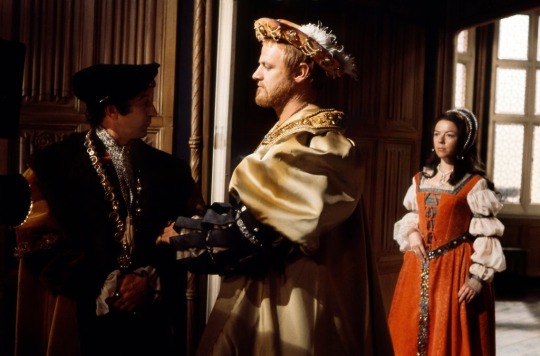

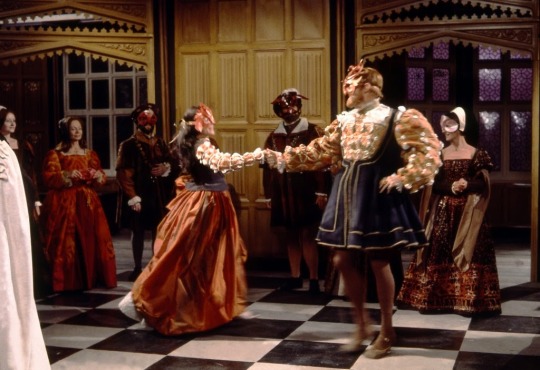
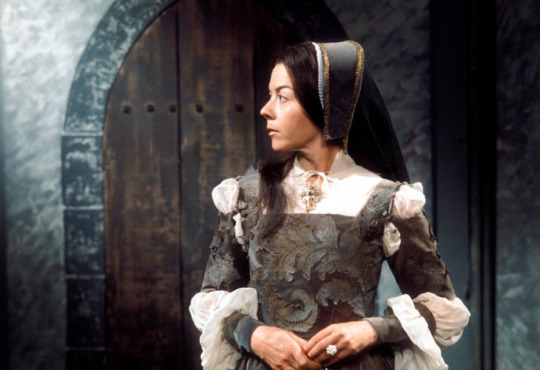

Dorothy Tutin as Anne Boleyn in The Six Wives of Henry VIII (1970)
edited by me; apologies for any remaining artifacts! I’ve tried to get rid of them all but it’s still somewhat visible in the first picture
First two pics are from episode 1 (”Catherine of Aragon”, written by Rosemary Anne Sisson); the rest are from episode 2 (”Anne Boleyn”, written by Nick Mccarty). Henry VIII was played by Keith Michell, Eustace Chapuys (in the second picture) by Edward Atienza, and Thomas Cranmer (in the last picture) by Bernard Hepton.
#tudor era#anne boleyn#dorothy tutin#the six wives of henry viii#henry viii#keith michell#eustace chapuys#edward atienza#thomas cranmer#bernard hepton#love this anne depiction so much#so lucky to have found this trove of pics a few days ago#dm me if you want access to the collection
53 notes
·
View notes
Text

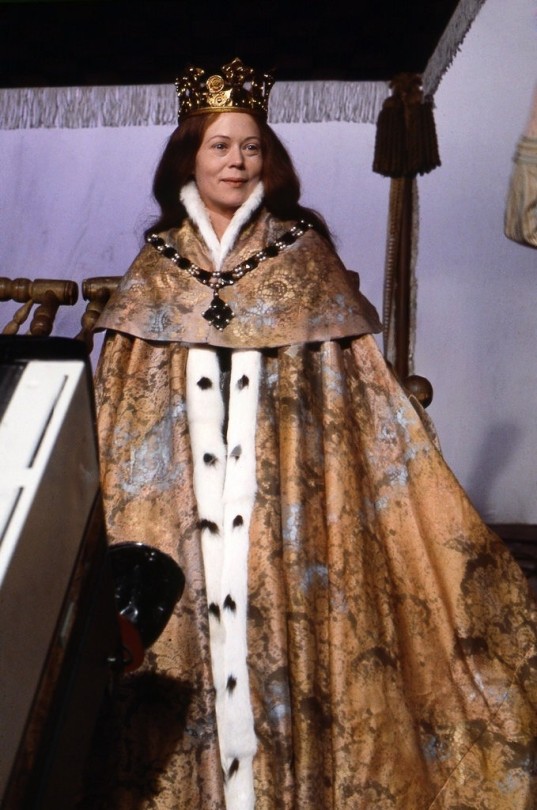

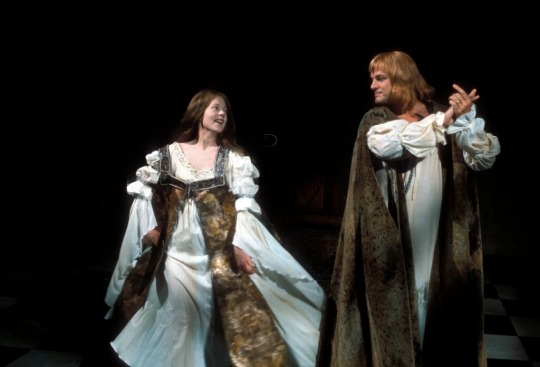
Annette Crosbie as Catherine of Aragon and Keith Michell as Henry VIII in The Six Wives of Henry VIII (1970), Episode 1: Catherine of Aragon (written by Rosemary Anne Sisson)
Edited by me; apologies for any remaining artifacts!
Maria de Salinas (1st pic) was played by Margaret Ford.
#tudor era#catherine of aragon#annette crosbie#henry viii#keith michell#the six wives of henry viii#love how it showed her younger years#bc it rly provides context as to why she fought the annulment sm#in addition to the obvious reasons#maria de salinas#margaret ford
41 notes
·
View notes
Text


Annette Crosbie as Catherine of Aragon and Margaret Ford as Maria de Salinas in The Six Wives of Henry VIII (1970), Episode 1: Catherine of Aragon (written by Rosemary Anne Sisson)
edited by me; apologies for any remaining artifacts!
Eustace Chapuys (2nd picture) was played by Edward Atienza.
#tudor era#catherine of aragon#annette crosbie#maria de salinas#margaret ford#eustace chapuys#edward atienza#the 1st pic is when she's ordered to separate from Mary#and the 2nd pic is when Suffolk asks for the christening cloth she used for Henry Duke of Cornwall but she refuses#just heartbreaking
19 notes
·
View notes
Quote
The bells of Bermondsey rang solemn and slow as Katherine's body was carried in procession towards Westminster... In the Abbey was the place prepared for her, beside King Harry, but before her coffin and effigy arrived there, her soul fled like a bird released from the fowler's net, and that human love which is stronger than death fled with it. Owen, riding, desolate, towards those two hills which men call the Gateway to Wales, was suddenly so conscious of that love that he turned and looked over his shoulder. He felt it alight upon him and sink down into his heart, simple, tender, warm and faithful, and knew that it would travel with him to his life's end.
The Queen and the Welshman, Rosemary Anne Sisson
#the queen and the welshman#rosemary anne sisson#quotes#catherine de valois#owen tudor#catherine de valois x owen tudor#books#1970s#so rosemary anne sisson wrote 3 versions of this as a play (2 televised in the 60s)#but she also wrote it as a novel in the 70s and i was curious enough to get hold of a copy#i'd imagine that it does contain a lot of elements of the play(s)#one quote nr the end she also uses as her dedication - to edward woodward who played it in the 50s theatre version
21 notes
·
View notes
Text
A head’s up for UK peoples interested in old time TV and/or history - BBC4 has started showing the 1971 BBC classic Tudor drama Elizabeth R starring Glenda Jackson. They’re up to Episode 2 “The Marriage Game” as of last night, but of course this also means it’s up on the iPlayer for the duration: https://www.bbc.co.uk/iplayer/episodes/p033w6j5/elizabeth-r
\o/
#elizabeth r#1970s#tudors#glenda jackson#elizabeth I#period drama#if you have any patience for very theatrical tv#this remains one of the greatest pieces of drama the bbc ever made#robert hardy#david collings#peter jeffrey#bernard horsfall#john shrapnel#herbert wise#rosemary anne sisson#(i can't remember who else is in it at this point#anthony ainley#briefly i recall)#robin ellis#even stunts by HAVOC at one point
37 notes
·
View notes
Photo








“When my mother was dying, they sent for me up at the big house. Sat by her bed and held her hand all night until she died. I didn’t know I wasn’t supposed to do that - but then I’m just a stupid, ignorant girl what doesn’t know any better. Only if I am, her ladyship must be also, because she sat beside me and held my hand. And in the morning, when my mother died and I was crying, she cried too.” (”For Love of Love”, Upstairs Downstairs LWT 1972)
“As I am now, I owe my life to no man's goodwill. Except the goodwill of the people and I have always known how to keep that.” (”The Marriage Game,” Elizabeth R, BBC 1971).
“He’s not like the Plantagenets, he’s a Tudor. There’s nothing secret about the Plantagenets, they know what they want and they try to get it. But the Tudors... there is always something in their hearts which is a mystery to themselves and to everyone else.” (”Crown in Jeopardy,” The Shadow of the Tower BBC 1972)
“He’d rather die than admit he’s wrong and she’d rather die than spoil a good exit.” (”The King Shall Not Die” The Bretts BBC 1987).
“You work in the City? ... Oh, don’t say worse luck. Say thank God! You know the phrase I hear most often at English country parties? What shall we do? All those intelligent and capable young men and women saying what shall we do? They sneer at me for being in business... I put up with it... But if I had to be one of those idle young men, marry one of those idle young women... I’d shoot myself.” (”A Change of Scene” Upstairs Downstairs LWT 1973).
Our queen - when danger threatened, turned her ship's head into the wind, and held it upon the only course she knew - the course of truth. It struck upon the rocks of passion and circumstance, and all aboard perished... But they did not disappear without a trace, as they might otherwise have done. Some spars and timbers of that ship remained to show... That there were human beings there. And that they cared profoundly about the terms on which they lived and died.” (”Catherine of Aragon” The Six Wives of Henry VIII BBC 1970).
#rosemary anne sisson#gif#quotes#the shadow of the tower#the duchess of duke street#the bretts#upstairs downstairs#the six wives of henry viii#elizabeth r#jean marsh#annette crosbie#glenda jackson#norma west#gemma jones#barbara murray#1970s#1980s#women in tv#so the upstairs downstairs extras#actually included a documentary#and my excitement#when suddenly there was rosemary anne sisson#was v funny#but her writing is excellent#and balanced#and well-researched#and compassionate#in a very low-key way#so i made this#because i could
26 notes
·
View notes
Photo



Endless list of ships: Elizabeth of York/Henry VII (The Shadow of the Tower BBC 1972).
“He will never come a-wooing. It is not in his nature. But he always does exactly what he means to do. And if he is marrying me, it is because he wants to.” (”Crown in Jeopardy” - Rosemary Anne Sisson.)
#the shadow of the tower#gif#henry vii x elizabeth of york#james maxwell#tbs endless list of ships#norma west#henry vii#elizabeth of york#rosemary anne sisson#quotes#1970s#tudors#ian thorne
37 notes
·
View notes
Photo




“My dearest mother... here I am. Where you always meant me to be.”
“Did I?”
Margaret Beaufort and Henry VII reunited in The Shadow of the Tower (BBC 1972).
#gif#The Shadow of the Tower#margaret beaufort#marigold sharman#henry vii#James Maxwell#1970s#period drama#tudors#mothers & sons#quotes#rosemary anne sisson
110 notes
·
View notes